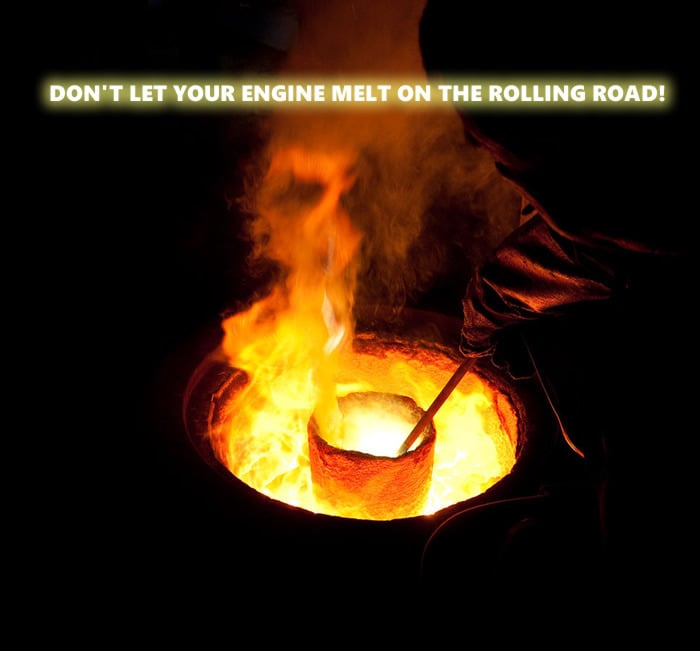Don't let your turbo engine get melted on a rolling road

A potential customer contacted me recently, to gauge my opinion on his recent calamitous rolling road session, which had resulted in melted spark plugs, and as yet unknown damage, on his high power turbo engine.
If you take your car for a rolling road session you might want to check the small print around liability. One would imagine most operators seek to exonerate themselves of all responsibility, because let's face it, they are going to come across plenty of engines that haven't been properly put together. On the flip-side though, the customer is right to expect that the person changing the fuel and timing parameters on their vehicle, is suitably expert and understands the ramifications of mistakes.
The engine had in fact been running in another vehicle, so the fuelling and ignition timing, whilst perhaps not optimised, were certainly in the ballpark. The rolling road session commenced and the engine which should have made approx 400hp made 250hp at 4000 rpm. The session stopped at this point as damage had already occurred.
When the customer checked what changes had been made to the mapping, he was surprised to find that the operator had reduced the amount of fuel and increased the ignition advance. The aim of rolling road tuning is to optimise the fuel and ignition timing to give the most power and torque, safely. That last word is clearly key. You may find a small gain in horsepower from more ignition advance, but eventually the law of diminishing returns kicks in. The optimal spark timing is the minimum amount of advance required to give the maximum amount of power. So, for example, let's say a 5° increase in spark timing liberated 20 hp and then a further 2° increase in spark timing created just one horsepower, the safe and sensible figure is 2° less timing and the sacrifice of that small increase. Vehicles operate in a wide range of conditions, fuel quality varies considerably, and it's always best to opt for “less is more”.
The customer didn't have access to AFR logs but my hunch would be that the mixture went closer to stoichiometric (14.7:1) which would necessitate less spark advance, when, in fact more was added. A good rolling road operator (email me for the contact details of the best) will be able to discern knock long before it's loud enough for most people to hear.
Knock or detonation is caused when parts of the fuel mixture ignite spontaneously rather than being lit by the flame front started at the spark plug. This results in the characteristic “Pinging” sound that we seldom hear nowadays, because most modern engines have knock control.
The effect of knock can be fairly inconsequential if minor, or completely catastrophic, particularly in the case of high-powered turbocharged engines.
Pre-ignition is knocks more deadly cousin. This happens when the air and fuel mixture ignites before the plug fires. This is usually as a result of a hotspot within the chamber, most typically the plug, but also other causes are deposits on the exhaust valves, a sharp edge on a valve or chamber. The terms are often misused, and you can actually have pre-ignition caused by knock. Ignition timing that is too advanced, can cause knock and then this can be followed by more dangerous pre- ignition. Combine a fuel mixture that is close to stoichiometric, with too much spark timing and it can all be over in a flash.
This is the reality of what happened to this man's engine, but whether he'll have any luck, claiming against the operator of the rolling road, remains to be seen.
What can you do to prevent this happening?.
If you are building a high-power turbocharged engine, you'll probably be using a stand-alone ECU, such as the Emerald unit which we have experience of, and highly recommend. There are a number of ways that you can map a turbo engine, for example a percentage of fuel increase compared to boost level, and a reduction in spark vs boost. the most useful metric to ensure that your base map is not going to immediately lunch the mechanicals is to add 10% more fuel for each 0.1 bar boost increase over atmospheric. So if you run 0.4 bar of boost (1.4 bar absolute) then you need to increase fuel supply by 40% over the base map. You'll be surprised how close this gets you to optimum fuelling, assuming you are working of a proven base map.
The second metric is for ignition – and for this good old PSI comes to the fore. Simply remove 1 degree of spark advance for each pound of boost you add. When I developed the Citroen C1 GTI engine this is how I built the map for the piggy back AEM ecu. To the best of my knowledge this car is still going strong some 60000 miles later. It was fettled on a rolling road but only very minor changes were made.
If you're going to get your car remapped, get a handle on the basics so you can be sure you're dealing with a reputable operator, who isn't going to melt your engine and then just shrug their shoulders and assume it was your engine building at fault.
GOOD LUCK!










